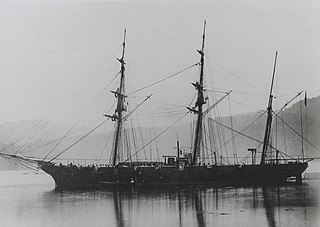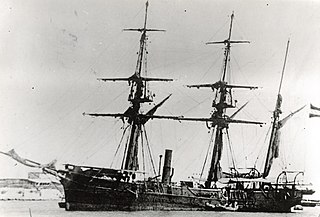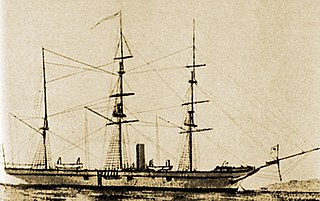The Adder-class monitors were a group of six ironclad monitors built for the Royal Netherlands Navy in the 1870s.

The Heiligerlee-class monitors were a group of five ironclad monitors built for the Royal Netherlands Navy in the late 1860s.

HNLMS Heiligerlee, formerly known as Panter, was a Heiligerlee-class monitor built in England for the Royal Netherlands Navy in the 1860s. Among the new ships built for the Dutch navy Heiligerlee was the first true monitor: a ship with shallow draught, only a few (heavy) guns and decent armor. These characteristics made her very suitable to operate way inland in the Dutch delta.

The Djambi class was a class of steam corvettes of the Royal Netherlands Navy. The class comprised Djambi, Zoutman, Willem, Leeuwarden, Metalen Kruis and Curaçao. Later two ships of a supposedly 'slightly revised' type were built, the Zilveren Kruis-class corvettes.

The Watergeus class was a class of screw sloop-of-war of the Royal Netherlands Navy. The class comprised the 'Watergeus' and the Marnix. A third ship that had been planned was cancelled.

The Zilveren Kruis class was a class of two steam-powered corvettes of the Royal Netherlands Navy. The class comprised Zilveren Kruis and Van Galen.

The Groningen class was a class of steam corvettes of the Royal Netherlands Navy. The class comprised Groningen, Citadel van Antwerpen and Vice-Admiraal Koopman

The Evertsen class was a class of steam frigates of the Royal Netherlands Navy. The class comprised Evertsen and Zeeland

The Vesuvius class was a class of steam screw sloops of the Royal Netherlands Navy. The class comprised Vesuvius, Cornelis Dirks, Reinier Claessen, Het Loo, Reteh and Prinses Maria.

The Samarang class was a class of steam screw gunvessels of the Royal Netherlands Navy. The class originally comprised Samarang, Batavia and Makassar, but was later extended.

The Pontianak class was a class of steam screw gunvessels of the Royal Netherlands Navy.

The Riouw class was a class of four steam screw gunvessels of the Royal Netherlands Navy. They were the first composite built ships of the Dutch navy.

The Ever class was a class of 14 flat-iron gunboats of the Royal Netherlands Navy.

The Haarlemmermeer class was a class of nine gunvessels of the Royal Netherlands Navy. The class was a failure because of its extreme susceptibility to dry rot.

The Soestdijk class was a class of 8 gunvessels of the Royal Netherlands Navy. The class was built to the same design as the preceding Haarlemmermeer class, but proved far more durable.

The Bali class was a ship class of sloops of the Royal Netherlands Navy and Japanese Navy. The class comprised Bali, Kanrin Maru, Soembing and Chōyō Maru

The RML 16 cm No. 3, or Getrokken kanon van 16 cm No. 3 was a rifled muzzle loading gun. It was a Dutch attempt to cheaply provide rifled ordnance to its navy.

The RML 16 cm No. 1, or Getrokken kanon van 16 cm No. 1 was a rifled muzzle loading gun. It was the first Dutch rifled gun which had been designed as such.

The Anna Paulowna class was a class of steam frigates of the Royal Netherlands Navy. Only Anna Paulowna was completed, parts of Van Galen were used to build the steam corvette Zilveren Kruis.

The Bromo class were a class of large paddle-steamers (sloops) of the Royal Netherlands Navy in the Dutch East Indies. The class comprised Bromo (1874) and Merapi (1874).



















